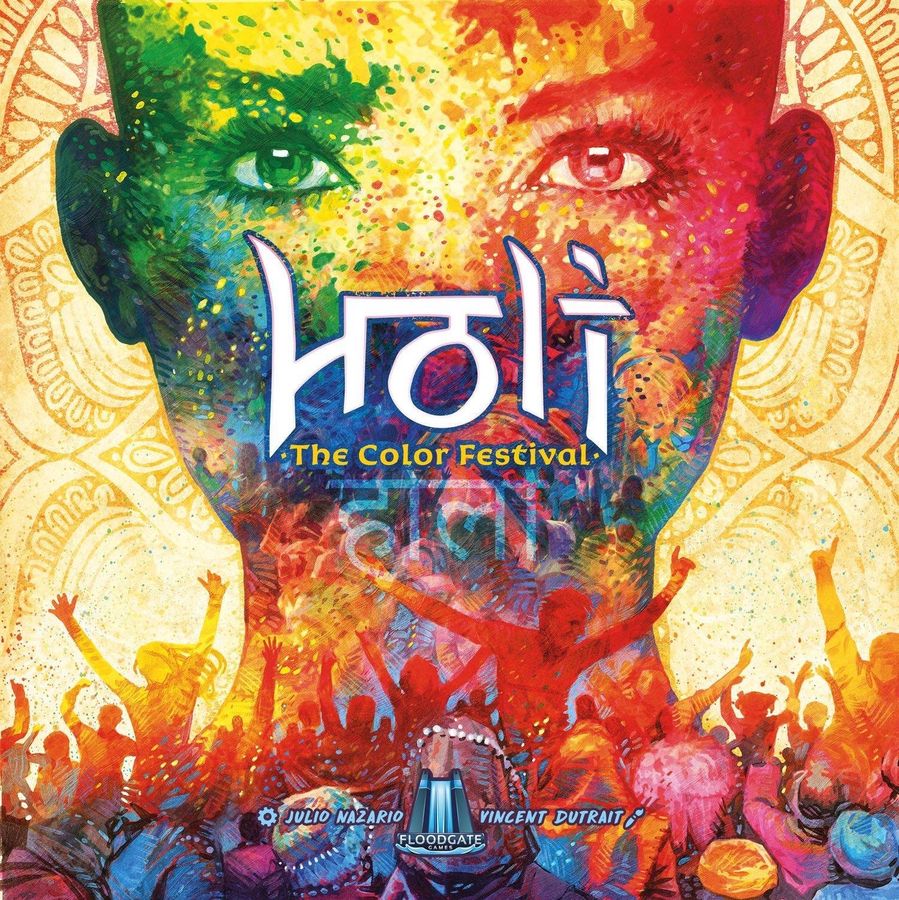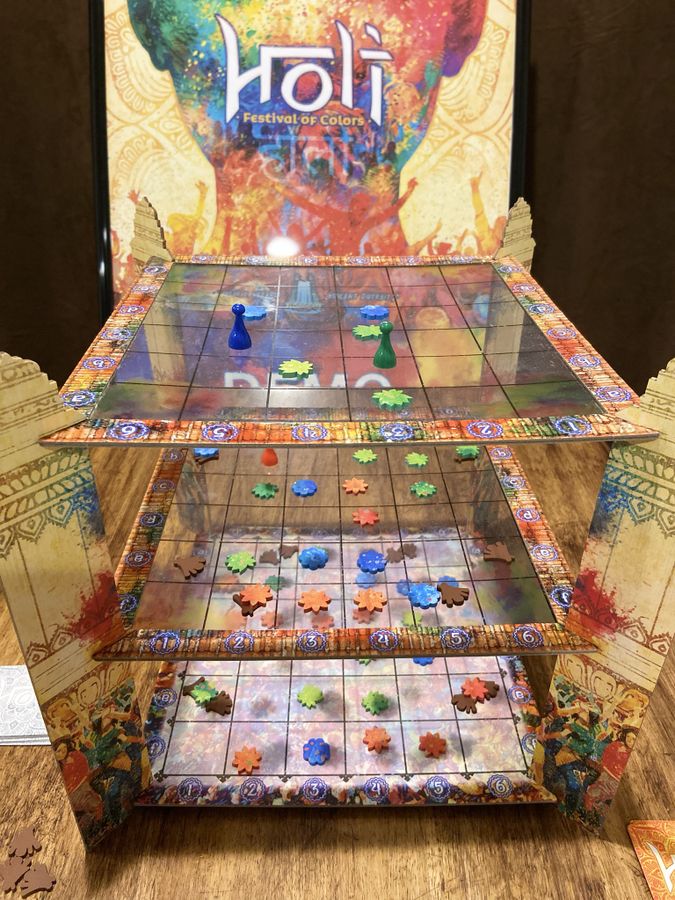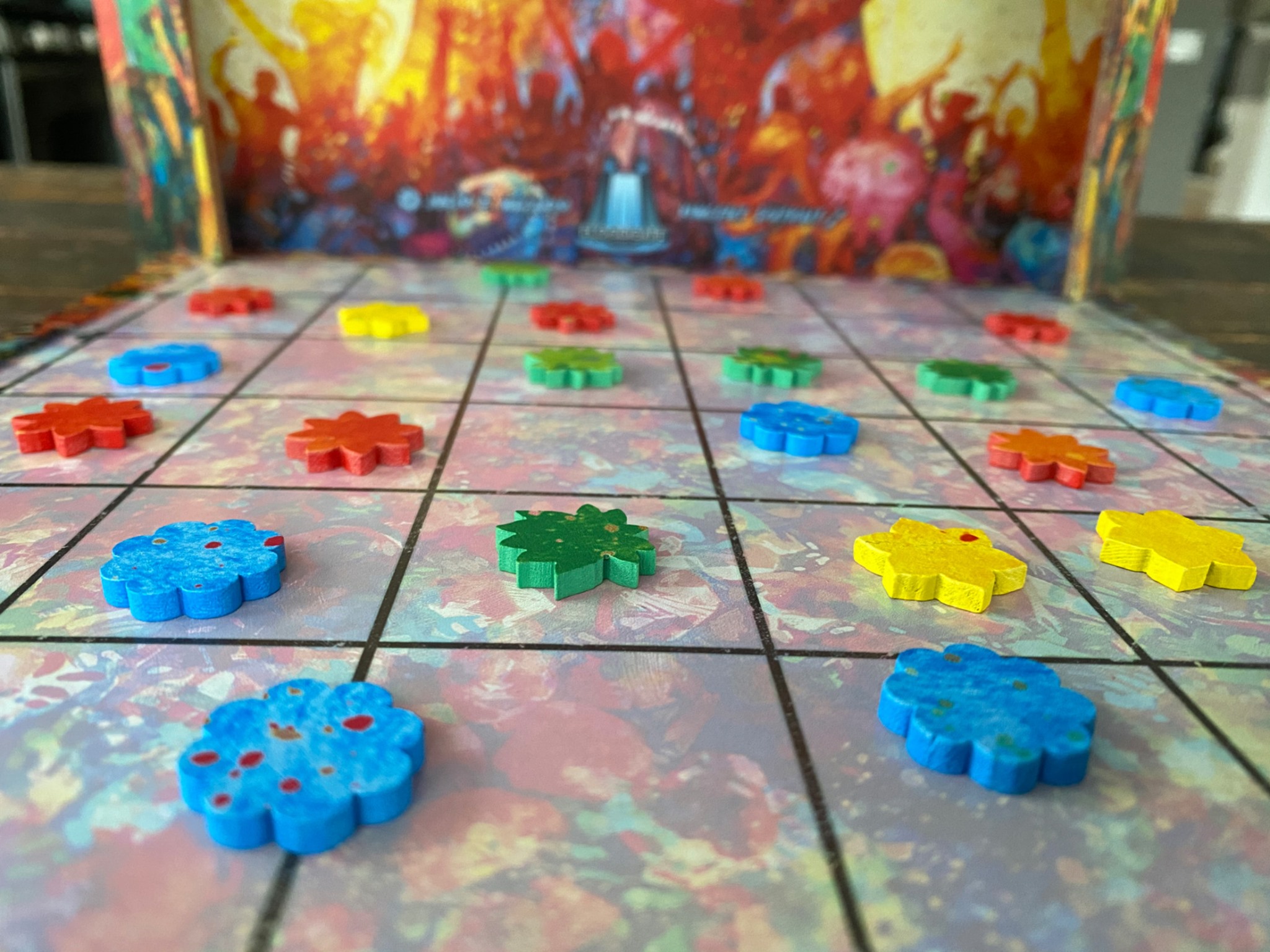Thanks to Ben Harkins of Floodgate Games for giving us a demo of Cosmic Colonies, Sagrada: Life, and Holi: Festival of Colors. You can see our preview of Cosmic Colonies here.
Designed by Julio E. Nazario and with art from Vincent Dutrait, this 2-4 player game is more than just a stunning presentation, although the 3D board and colourful artwork certainly helped catch our attention.

 Based off of an ancient Hindu festival whereby people gather to spread colour and cheer by throwing “gulaal” powder onto each other and the crowd, Holi encourages rivalry in a friendly, playful way.
Based off of an ancient Hindu festival whereby people gather to spread colour and cheer by throwing “gulaal” powder onto each other and the crowd, Holi encourages rivalry in a friendly, playful way.
Players compete by throwing colour on other players and across the three levels of the board, which represents a courtyard. Sweets can also be collected along the way to score additional points. This is an abstract game with elements of area control and action selection, creating plenty of opportunities for tactical and strategic decisions to be made.

The goal of the game is to spread as much of your colour as possible. The higher the level in which you spread your colour, the more points you’ll get. But it’s not particularly easy to climb higher, and even when it is, it might not always be the best choice.
Players start on the bottom level. On your turn, you can do three possible actions – throw colour, move your player piece, and climb up. You can do these three actions in any order, and throwing colour is the only mandatory action each turn.
Your player piece can be moved to any space not occupied by another player piece. If you move your player piece to a space that has a colour token or a Sweet token, you gain the appropriate token. But be careful! Players get 2 points at the end of the game for each token of their colour in the collective supplies of their opponents, so you don’t want to collect tokens of other colours unless you really need to get into a specific spot.

To throw colour, simply choose one of the colour cards in your hand – either a personal colour card or a global colour card – and place your colour tokens appropriately. One of the coloured spots must correspond to your player piece, and you’ll simply add your colour tokens to the other spots. These cards can be rotated in either direction.
If you throw colour when you’re on the second or third level, those colour tokens will fall through to the level below if there are no tokens on the same space below. Tokens can fall more than once. At the end of the game, tokens on the third level are worth 3 points, second level are worth 2 points, and tokens on the base level score 1 point.
The only way to climb up to a higher level is by having your player piece surrounded by colour tokens on all four adjacent sides, at which point you would simply use your climb up action to jump up one level to the same spot. If another player piece is already there, you cannot do this, and once you move up, you can never move back down again.

At the end of your turn, when you’ve completed as many of these three actions as you’d like, you draw cards in any combination from your player colour deck and the global colour card deck, until you have three cards in hand.
The game ends once any two piles of colour tokens are gone, any two colour decks are gone, or one of each. Players score points for colour tokens as previously stated, but they also compare Sweets with the other players. For each player you have more Sweets than, you score an additional 5 points.
The game also comes with rules cards that you can add, which either change a rule in some minor way, or provide additional scoring conditions. The rule cards are optional but add to the game’s variability and replayability.

 You can read all about the development of Holi: Festival of Colors in this Developer Diary from Ben Harkins of Floodgate Games. It’s clear that a lot of thought and care went into not only designing the game itself, but also ensuring this cultural tradition is treated with respect. Ben Harkins and the folks at Floodgate deserve credit for how they’ve captured this festival in a beautiful, thematic game that celebrates this tradition in such a positive light.
You can read all about the development of Holi: Festival of Colors in this Developer Diary from Ben Harkins of Floodgate Games. It’s clear that a lot of thought and care went into not only designing the game itself, but also ensuring this cultural tradition is treated with respect. Ben Harkins and the folks at Floodgate deserve credit for how they’ve captured this festival in a beautiful, thematic game that celebrates this tradition in such a positive light.
We can’t wait to see this on a table first-hand, and we’re just as excited to play it for ourselves.
What do you think of Holi: Festival of Colors? Does this remind you of any other games or is this totally unique? Let us know in the comments below!
Check back in the coming weeks for our preview of Sagrada: Life, the second expansion in a three-part series for Sagrada.
Leave a reply
You must be logged in to post a comment.







Gloomhaven: Triforce Class Guide
Gloomhaven: Triforce Class Guide
Men at Work – Review